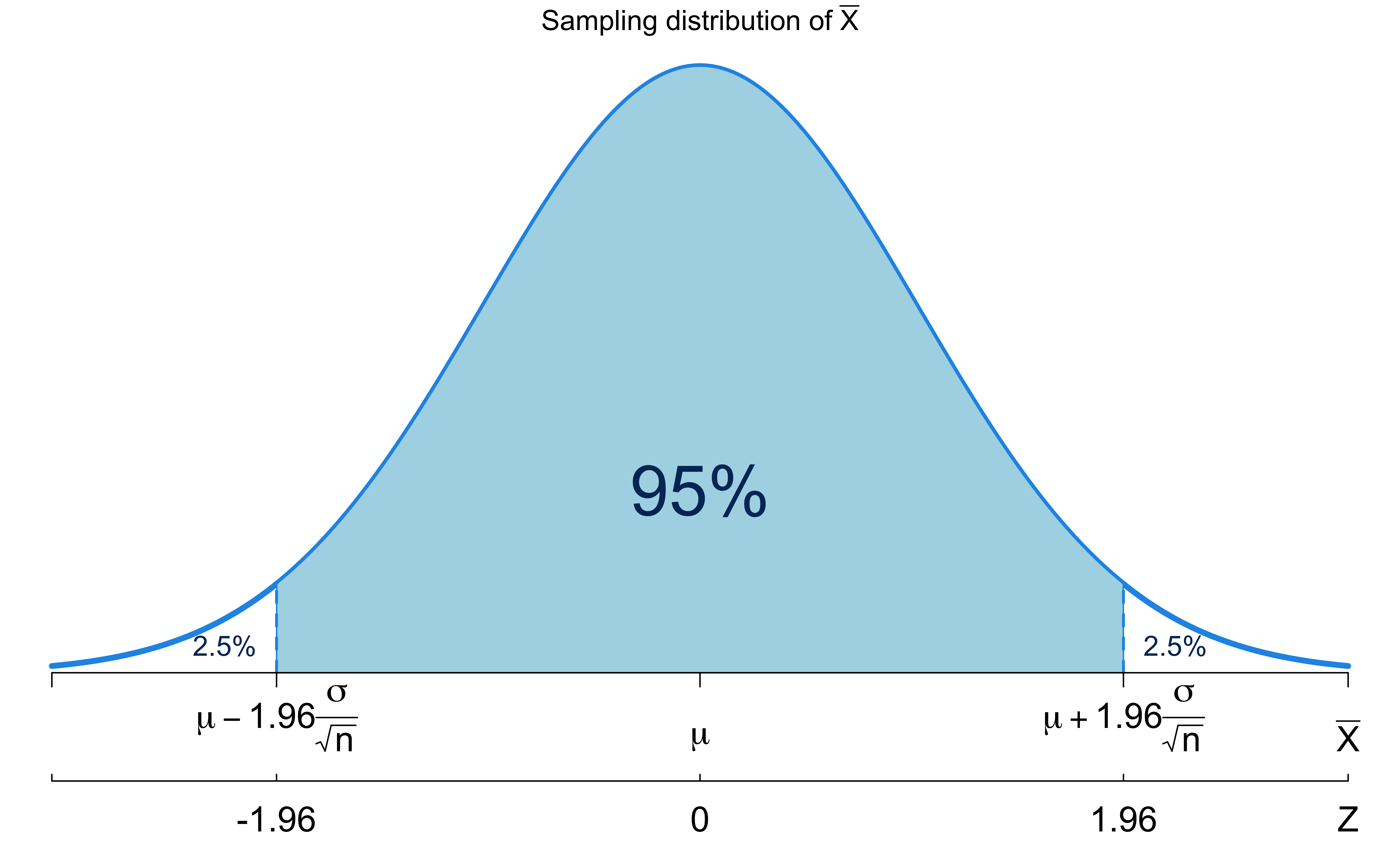
Statistical Inference: Point and Interval Estimation
MATH 4720/MSSC 5720 Introduction to Statistics
Department of Mathematical and Statistical Sciences
Marquette University
Foundations for Inference
Estimation: Point and Interval Estimation
Testing
Inference Framework
Inferential statistics uses sample data to learn about an unknown population.
-
Idea: Assume the target population follows some distribution but with unknown parameters.
- Assume the population is normally distributed, but don’t know its mean and/or variance. Marquette students’ mean GPA for example.
Goal: Learning the unknown parameters of the assumed population distribution.
Two approaches in parameter learning: Estimation and Hypothesis testing.

Point Estimator
If you can use only one single number to guess the unknown population mean \(\mu\), what would you like to use?
The one single point used to estimate the unknown parameter is called a point estimator.
-
A point estimator is any function of data \((X_1, X_2, \dots, X_n)\) (Before actually being collected).
- Any statistic is a point estimator.
A point estimate is a value of a point estimator used to estimate a population parameter. (A value calculated using the collected data).
Sample mean \((\overline{X})\) is a statistic and a point estimator for the population mean \(\mu\).
Sample Mean as an Point Estimator
- Draw 5 values from the population that follows \(N(3.2, 0.5)\) as sample data \((x_1, x_2, x_3, x_4, x_5)\).
| x1 | x2 | x3 | x4 | x5 | sample mean |
|---|---|---|---|---|---|
| 2.88 | 2.94 | 3.09 | 2.66 | 2.38 | 2.79 |
- \(\mu = 3.2\), and we use the point estimate \(\overline{x}=\) 2.79 to estimate it.
Why \(\overline{x}\) is not equal to \(\mu\)?
Due to its randomness nature

Variability in Estimates
- If another sample of size \(5\) is drawn from the same population:
| x1 | x2 | x3 | x4 | x5 | sample mean |
|---|---|---|---|---|---|
| 2.35 | 3.4 | 3.97 | 1.54 | 3.5 | 2.95 |
- The second sample mean \(\overline{x} =\) 2.95 is different from the first one.
Why the first sample and the second sample give us different sample means?
A point estimator has its own sampling distribution

Why Point Estimates Are Not Enough
If you want to estimate \(\mu\), do you prefer to report a range of values the parameter might be in, or a single estimate like \(\overline{x}\)?
If you want to catch a fish, do you prefer a spear or a net?


- Due to variation of \(\overline{X}\), if we report a point estimate \(\overline{x}\), we probably won’t hit the exact \(\mu\).
- If we report a range of plausible values, we have a better shot at capturing the parameter!
Confidence Intervals
A plausible range of values for \(\mu\) is called a confidence interval (CI).
To construct a CI we need to quantify the variability of our sample mean.
-
Quantifying this uncertainty requires a measurement of how much we would expect the sample statistic to vary from sample to sample.
- That is the variance of the sampling distribution of the sample mean!
👉 The larger variation of \(\overline{X}\) is, the wider the CI for \(\mu\) will be, given the same “level of confidence”.
Do we know the variance of \(\overline{X}\)?
- By CLT, \(\overline{X} \sim N(\mu, \sigma^2/n)\) regardless of what the population distribution is.
Confidence Interval Is for a Parameter
-
A confidence interval is for a parameter, NOT a statistic.
- Use the sample mean to form a confidence interval for the population mean.
We never say “The confidence interval of the sample mean \(\overline{X}\) is …”
We say “The confidence interval for the true population mean \(\mu\) is …”
- In general, a confidence interval for \(\mu\) has the form
\(\large \overline{x} \pm m = (\overline{x} - m, \overline{x} + m)\)
The \(m\) is called margin of error.
\(\overline{x} - m\) is the lower bound and \(\overline{x} + m\) is the upper bound of the confidence interval.
The point estimate \(\overline{x}\) and margin of error \(m\) can be obtained from known quantities and our data once sampled.
Precision vs. Reliability
If we want to be very certain that we capture \(\mu\), should we use a wider or a narrower interval? What drawbacks are associated with using a wider interval?

With the sample size fixed, precision and reliability have a trade-off relationship.
\((1 - \alpha)100\%\) Confidence Intervals
The confidence level \(1-\alpha\): the proportion of times that the CI contains the population parameter, assuming that the estimation process is repeated a large number of times.
-
The common choices for the confidence level are
- 90% \((\alpha = 0.10)\)
- 95% \((\alpha = 0.05)\)
- 99% \((\alpha = 0.01)\)
95% is the most common level because of good balance between precision (width of the CI) and reliability (confidence level)
High reliability and Low precision. I am 100% confident that the mean height of Marquette students is between 3’0” and 8’0”. duh…🤷
Low reliability and High precision. I am 20% confident that mean height of Marquette students is between 5’6” and 5’7”. far from it…🙅
\(95\%\) Confidence Intervals for \(\mu\): Z-score
\(\alpha = 0.05\)
Start with the sampling distribution of \(\overline{X} \sim N\left(\mu, \frac{\sigma^2}{n}\right)\)
\(\overline{x}\) will be within 1.96 SDs of the population mean \(\mu\) \(95\%\) of the time.
The \(z\)-score of 1.96 is associated with 2.5% area to the right, and called a critical value denoted as \(z_{0.025}\).

\(95\%\) Confidence Intervals for \(\mu\): Probability
\[P\left(\mu-1.96\frac{\sigma}{\sqrt{n}} < \overline{X} < \mu + 1.96\frac{\sigma}{\sqrt{n}} \right) = 0.95\]
Is the interval \(\left(\mu-1.96\frac{\sigma}{\sqrt{n}}, \mu+1.96\frac{\sigma}{\sqrt{n}} \right)\) our confidence interval?
❌ No! We don’t know \(\mu\), the quantity we like to estimate!
But we’re almost there!

\(95\%\) Confidence Intervals for \(\mu\): Formula
\[ \small P\left(\mu-1.96\frac{\sigma}{\sqrt{n}} < \overline{X} < \mu + 1.96\frac{\sigma}{\sqrt{n}} \right) = 0.95 \iff P\left( \boxed{\overline{X}-1.96\frac{\sigma}{\sqrt{n}} < \mu < \overline{X} + 1.96\frac{\sigma}{\sqrt{n}}} \right) = 0.95\]
With sample data of size \(n\), \(\left(\overline{x}-1.96\frac{\sigma}{\sqrt{n}}, \overline{x} + 1.96\frac{\sigma}{\sqrt{n}}\right)\) is our \(95\%\) CI for \(\mu\) if \(\sigma\) is known to us!
The margin of error \(m = 1.96\frac{\sigma}{\sqrt{n}}\).

Confidence Intervals for population Means: Known Variance Case
Confidence Intervals for \(\mu\) When \(\sigma\) is Known
Requirements for estimating \(\mu\) when \(\sigma\) is known:
-
👉 The sample should be a random sample, i.e. All data \(X_i\) are drawn from the same population, and \(X_i\) and \(X_j\) are independent.
- Any methods in the course are based on a random sample
👉 The population standard deviation \(\sigma\) is known.
-
👉 The population is either normally distributed or \(n > 30\) or both, i.e., \(X_i \sim N(\mu, \sigma^2)\).
- \(n > 30\) allows CLT to be applied and hence normality is satisfied.
\((1-\alpha)100\%\) Confidence Intervals for \(\mu\):

\(\left(\overline{x}-1.96\frac{\sigma}{\sqrt{n}}, \overline{x} + 1.96\frac{\sigma}{\sqrt{n}}\right)\) \(\left(\overline{x}-z_{0.025}\frac{\sigma}{\sqrt{n}}, \overline{x} + z_{0.025}\frac{\sigma}{\sqrt{n}}\right)\)

\(\left(\overline{x}-z_{\alpha/2}\frac{\sigma}{\sqrt{n}}, \overline{x} + z_{\alpha/2}\frac{\sigma}{\sqrt{n}}\right)\)
Confidence Intervals for \(\mu\) When \(\sigma\) is Known
Procedures for constructing a confidence interval for \(\mu\) when \(\sigma\) known:
- Check that the requirements are satisfied.
- Decide \(\alpha\) or confidence level \((1 - \alpha)\).
- Find the critical value \(z_{\alpha/2}\).
- Evaluate margin of error \(m = z_{\alpha/2} \cdot \frac{\sigma}{\sqrt{n}}\)
- Construct the \((1 - \alpha)100\%\) CI for \(\mu\) using sample mean \(\overline{x}\) and margin of error \(m\):
\[\left( \overline{x} -z_{\alpha/2}\frac{\sigma}{\sqrt{n}}, \, \overline{x} + z_{\alpha/2} \frac{\sigma}{\sqrt{n}}\right)\]
Example: CI for \(\mu\) When \(\sigma\) is Known
We want to know the mean systolic blood pressure (SBP) of a population.
Assume that the population distribution is normal with the standard deviation of 5 mmHg.
We have a random sample of 16 subjects of this population with mean 121.5.
Estimate the mean SBP with a 95% confidence interval.

- Requirements: Normality is assumed, \(\sigma = 5\) is known and a random sample is collected.
- Decide \(\alpha\): \(\alpha = 0.05\)
- Find the critical value \(z_{\alpha/2}\): \(z_{\alpha/2} = z_{0.025} = 1.96\)
- Evaluate margin of error \(m = z_{\alpha/2} \frac{\sigma}{\sqrt{n}}\): \(m = (1.96) \frac{5}{\sqrt{16}} = 2.45\)
- Construct the \((1 - \alpha)100\%\) CI: The 95% CI for the mean SBP is \(\overline{x} \pm z_{\alpha/2}\frac{\sigma}{\sqrt{n}} = (121.5 -2.45, 121.5 + 2.45) = (119.05, 123.95)\)
Computation in R
## save all information we have
alpha <- 0.05
n <- 16
x_bar <- 121.5
sig <- 5
## 95% CI
## z-critical value
(cri_z <- qnorm(p = alpha / 2, lower.tail = FALSE)) [1] 1.96## margin of error
(m_z <- cri_z * (sig / sqrt(n))) [1] 2.45## 95% CI for mu when sigma is known
x_bar + c(-1, 1) * m_z [1] 119.1 123.9Construct a 99% CI for the mean SBP. Do you expect to have a wider or narrower interval? Why?
Interpreting a Confidence Interval
“We are 95% confident that the mean SBP lies between 119.1 mm and 123.9 mm.”
Suppose we were able to collect our dataset many times and build the corresponding CIs.
-
We would expect about 95% of those intervals would contain the true population parameter, here the mean systolic blood pressure.
- Remember: \(\overline{x}\) varies from sample to sample, so does its corresponding CI.
We never know if in fact 95% of them do, or whether any interval contains the true parameter!
Generate 100 Confidence Intervals Assuming \(\mu = 120\).

Interpreting a Confidence Interval DO NOT SAY
- WRONG ❌ “There is a 95% chance/probability that the true population mean will fall between 119.1 mm and 123.9 mm.”
- WRONG ❌ “The probability that the true population mean falls between 119.1 mm and 123.9 mm is 95%.”
- 👉 The sample mean is a random variable with a sampling distribution, so it makes sense to compute a probability of it being in some interval.
- 👉 The population mean is unknown and FIXED. We cannot assign or compute any probability of it.
- Another inference method, Bayesian inference, treats \(\mu\) as a random variable and therefore we can compute any probability associated with it. (MATH 4790 Bayesian Statistics)
Confidence Intervals for population Mean \(\mu\): Unknown Variance Case
Confidence Intervals for \(\mu\) When \(\sigma\) is Unknown
\(\sigma^2 = \frac{\sum_{i=1}^{N}(x_i - \mu)^2}{N}\), \(N\) is the population size.
It’s rare that we do not know \(\mu\), but know \(\sigma\).
We use the Student t distribution to construct a confidence interval for \(\mu\) when \(\sigma\) is unknown.
-
Still need
- Random sample
- Population is normally distributed and/or \(n > 30\).
What is a natural estimator for the unknown \(\sigma\)?
- Since \(\sigma\) is unknown, we use the sample standard deviation \(S = \sqrt{\frac{\sum_{i=1}^{n}(X_i - \overline{X})^2}{n-1}}\) instead when constructing the CI.
Student t Distribution
- If the population is normally distributed or \(n > 30\),
- \(\overline{X} \sim N\left(\mu, \frac{\sigma^2}{n} \right)\)
- \(Z = \frac{\overline{X} - \mu}{\color{red}\sigma/\sqrt{n} } \sim N(0, 1)\)
- \(T = \frac{\overline{X} - \mu}{\color{red}S/\sqrt{n} } \sim t_{n-1}\)
- \(t_{n-1}\) denotes the Student t distribution with degrees of freedom (df) \(n-1\).
Properties of Student t Distribution
Symmetric about the mean 0 and bell-shaped as \(N(0, 1)\).
More variability than \(N(0, 1)\) (heavier tails and lower peak).
The variability is different for different sample sizes (degrees of freedom).
As \(n \rightarrow \infty\) \((df \rightarrow \infty)\), the Student t distribution approaches to \(N(0, 1)\).

Critical Values of \(t_{\alpha/2, n-1}\)
- When \(\sigma\) is unknown, we use \(t_{\alpha/2, n-1}\) as the critical value, instead of \(z_{\alpha/2}\).

With the same \(\alpha\), \(t_{\alpha, n-1}\) or \(z_{\alpha}\) is larger?
Critical Values of \(t_{\alpha/2, n-1}\)
Given the same confidence level \(1-\alpha\), \(t_{\alpha/2, n-1} > z_{\alpha/2}\).
| Level | t df = 5 | t df = 15 | t df = 30 | t df = 1000 | t df = inf | z |
|---|---|---|---|---|---|---|
| 90% | 2.02 | 1.75 | 1.70 | 1.65 | 1.64 | 1.64 |
| 95% | 2.57 | 2.13 | 2.04 | 1.96 | 1.96 | 1.96 |
| 99% | 4.03 | 2.95 | 2.75 | 2.58 | 2.58 | 2.58 |
CI for \(\mu\) When \(\sigma\) is Unknown
The \((1-\alpha)100\%\) confidence interval for \(\mu\) when \(\sigma\) is unknown is \[\left(\overline{x} - t_{\alpha/2, n-1} \frac{s}{\sqrt{n}}, \overline{x} + t_{\alpha/2, n-1} \frac{s}{\sqrt{n}}\right)\]
Given the same confidence level \(1-\alpha\), \(t_{\alpha/2, n-1} > z_{\alpha/2}\).
We are more “uncertain” when doing inference about \(\mu\) because we also don’t have information about \(\sigma\), and replacing it with \(s\) adds additional uncertainty.
Computation in R (t interval)
Back to the systolic blood pressure (SBP) example. We have \(n=16\) and \(\overline{x} = 121.5\).
Estimate the mean SBP with a 95% confidence interval with unknown \(\sigma\) and \(s = 5\).
alpha <- 0.05
n <- 16
x_bar <- 121.5
s <- 5 ## sigma is unknown and s = 5
## t-critical value
(cri_t <- qt(p = alpha / 2, df = n - 1, lower.tail = FALSE)) [1] 2.131## margin of error
(m_t <- cri_t * (s / sqrt(n))) [1] 2.664## 95% CI for mu when sigma is unknown
x_bar + c(-1, 1) * m_t [1] 118.8 124.2Summary
| Numerical Data, \(\sigma\) known | Numerical Data, \(\sigma\) unknown | |
|---|---|---|
| Parameter of Interest | Population Mean \(\mu\) | Population Mean \(\mu\) |
| Confidence Interval | \(\bar{x} \pm z_{\alpha/2} \frac{\sigma}{\sqrt{n}}\) | \(\bar{x} \pm t_{\alpha/2, n-1} \frac{s}{\sqrt{n}}\) |
- Remember to check if the population is normally distributed or \(n>30\).
- What if the population is not normal and \(n \le 30\)?
- Use a so-called nonparametric method, for example bootstrapping. (Your project?!)